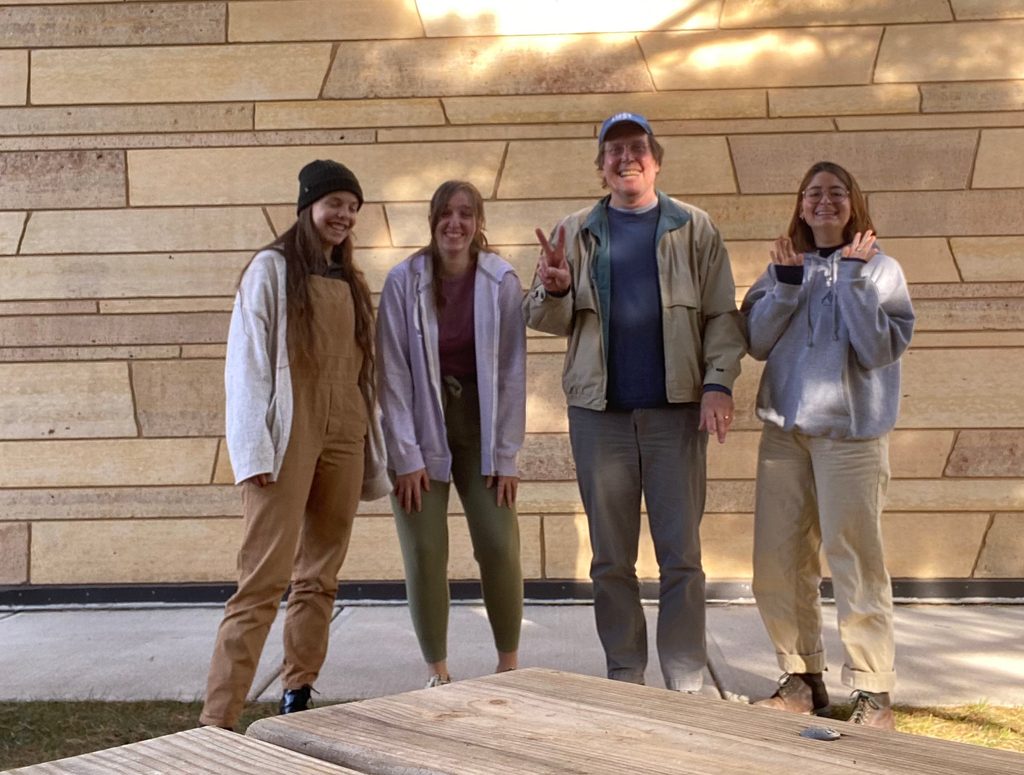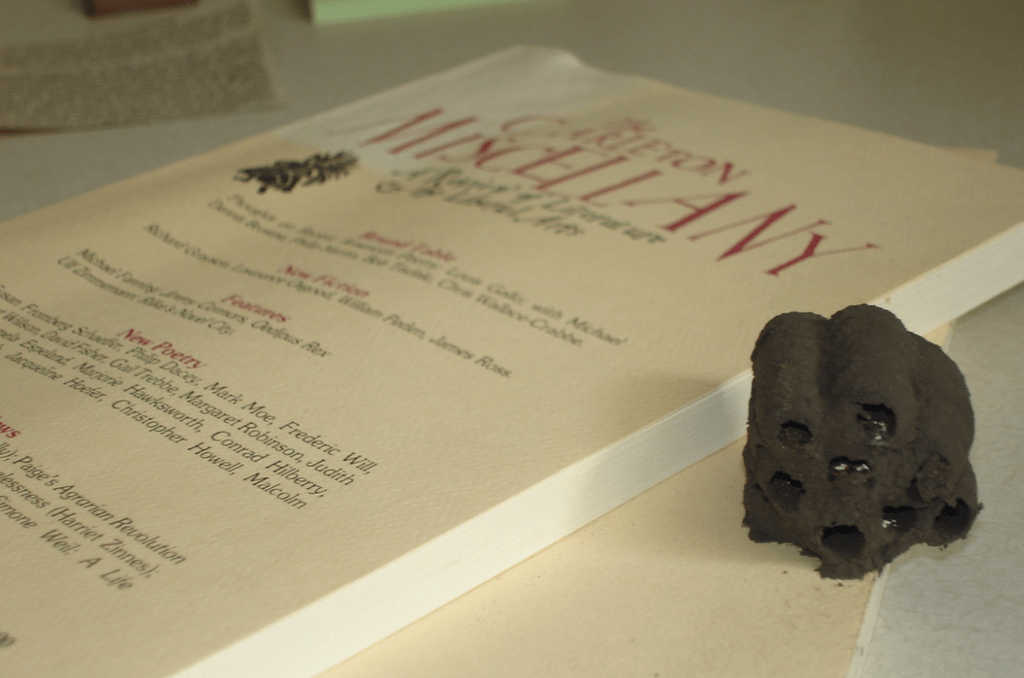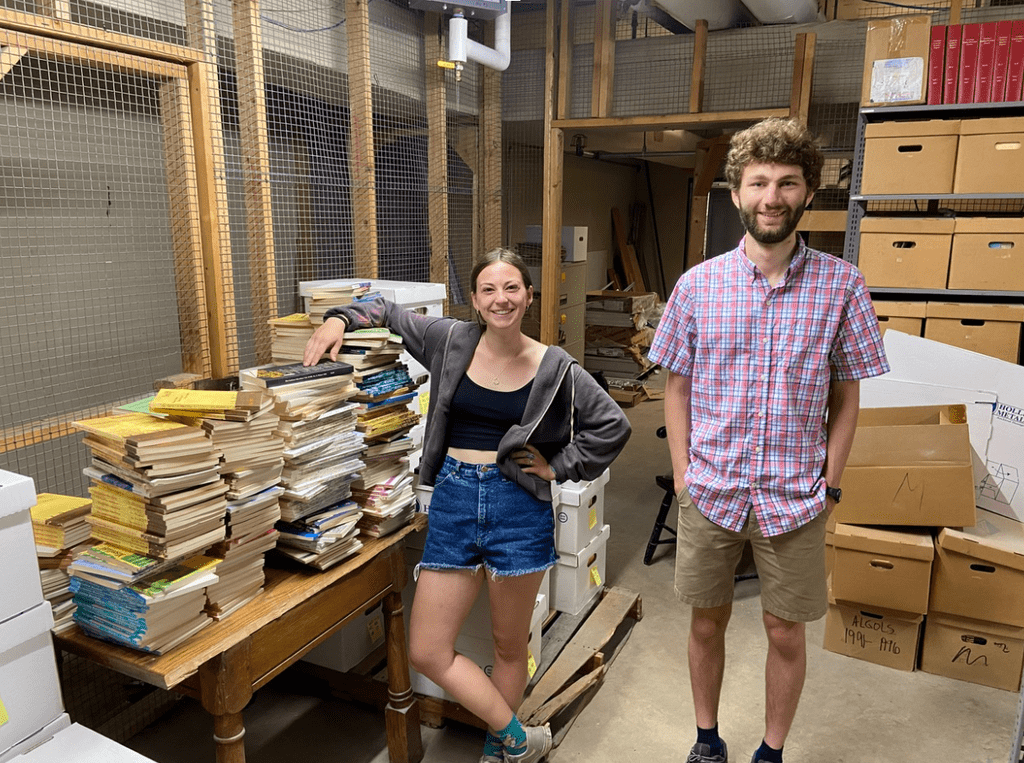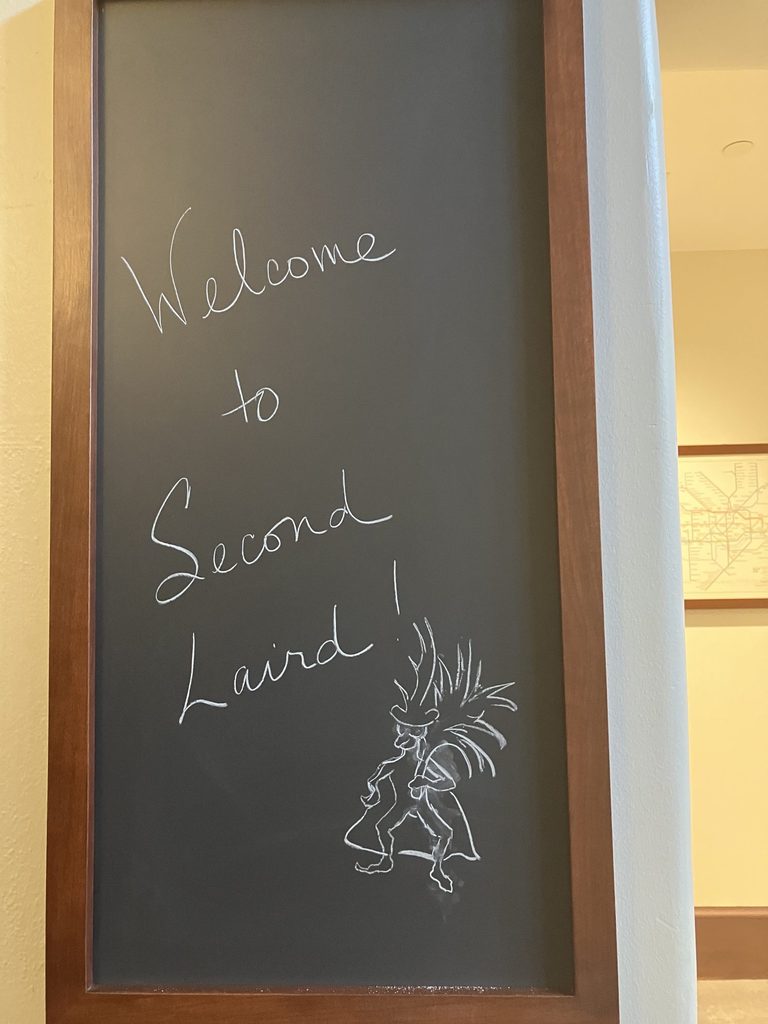
When we first learned that Professor Mike Kowalewski would be giving a talk on the Miscellany, all of us here at the Second Laird Miscellany were flattered, if a little surprised. (We hadn’t even spoken yet!) Unfortunately, once we spoke with Mike and attended his presentation, we realized that he wasn’t talking about the SLM at all, but our charming predecessors. (Fear not, our day shall come.) As a consolation, however, we *did* manage to get some pretty fantastic insight into our celebrated heritage and the history of Laird, English at Carleton, and, of course, the impishness that lies beneath.
The Carleton Miscellany was once a renowned national literary magazine—the height of literary culture—though it had been consigned to obscurity by the time Mike started at Carleton in 1991. When he arrived on campus, the Miscellany was already gone, but “two of the editors, Wayne Carver and Keith Harrison, were still here. They talked a lot about the magazine that had folded 11 years before.” Wayne and Keith took Mike by the hand (and by candlelight, we can only assume) to the third floor of Laird (which, as we learned, was perhaps campus’ best-kept-secret as a prime make-out—ahem, romantic—spot). There, they showed him “all these shelves and stuff. There were a couple of offices up there, but there were all these old copies of the Miscellany that were kind of piled up.” Mike became immediately enthralled by the romantic and mischievous history of the little magazine, the tales of “long reading sessions of manuscripts on second Laird late into Friday evenings.”
Since then, Mike has combed through the reserves, working to rescue the legacy of this little magazine from literary obscurity. Facing down wasp’s nests and the deep dark depths of Goodhue storage, he’s been rewarded with gems that highlight how significant this part of Carleton’s literary history really is. “We ran across this essay that just was, like I said, my hands were sort of trembling a little bit when I was reading it.” What was the work that made this professor so shaky?


The American Studies department used to run an honors seminar which invited a variety of visitors to come and speak to the students. “The Miscellany would then publish condensed edited transcripts of the student interaction with visitors and all of that. And so we ran across this one that was just remarkable.” This was a talk on democracy and the arts by August Heckscher, who was eventually named the White House Special Consultant on the Arts by President John F. Kennedy. Funnily enough, the transcript of the talk ends with a cliffhanger, as the tape runs out (Mike cites this, rightly so, as definitive proof that humanities scholars have never been good with technology). According to Mike, “That’s when I really decided, ‘Okay, I’ve got to, I’ve got to find out more about this.’”
The Miscellany itself was the brainchild of Reed Whittemore, inspired by a previous magazine called Furioso which he had started as an undergraduate student at Yale, and featured big names including Ezra Pound and William Carlos Williams. When Whittemore arrived at Carleton, he apparently made quite the impression. Mike remembers Whittemore as a “very fashionable guy,” notably being one of the first people to wear Bermuda shorts. Very fashionable indeed. But Bermuda shorts weren’t the only thing Whittemore brought with him. He brought with him the legacy of Furioso, manifesting in the glorious birth of the beloved Miscellany.

Part of this inheritance was the spirit of “undergraduate cheek” that Whittemore never lost, is what Mike thinks is “the hardest thing to convey about the magazine.” This cheekiness manifested itself in one of the other holdovers from Furioso: the inimitable imp, the presiding chimney sweep, “who is supposed to sweep away the sweat of pretension and arrogance” from the magazine. Indeed, the imp left its mark throughout the magazine, leaving “little squibs and line drawings and mock scholarly footnotes and editorial asides.” Mike also cleared up some misconceptions about the imp, explaining that it is “not a ‘he’… It’s actually a gender neutral image, although a lot of people refer to him as male.” The imp thus reveals itself to offer nuanced commentary on gender politics, not to mention representation as a nonbinary icon.
The phenomenon of the little magazine is also “really fascinating,” says Mike. “They’re always sort of subversive and under the radar and they see themselves opposed to big, glossy, popular magazines… mainstream modernism is all tied to little magazines. I mean, almost everybody we think of in American literature now was publishing in little magazines. They weren’t publishing in The New Yorker or in life or the Saturday Review — I mean, Fitzgerald did later after he got famous — but it was all these kinds of little magazines that weren’t big magazines.” The core of the little magazine was the issue itself: “I think that’s part of the excitement of being an editor of a little magazine as you’re turning out these little gifts to the world. You spend a lot of time trying to make it as lively and interesting as you can, as an individual issue.” Some examples: a retrospective on the 30s, and an issue promoting women’s poetry, all the way back in 1963. “It was really kind of exciting, you know, that part of it — having something new. And you knew the next issue was going to be coming out, which was also part of the fun of it.” Almost as exciting as anxiously waiting around for the next Second Laird Miscellany post, as we know you all do.
If you (like us) are feeling disappointed about missing such an exciting literary moment by a few decades, don’t worry. The little magazine is still an active part of the literary world. “There actually are something like 1,500 little magazines in the United States right now, with very small readerships. A lot of them have gone online and have a different format, or [are] sometimes called zines. And you know, and blogs and various things have sort of supplanted the print version of things. So that’s worked into it, the technology has changed. It is truly more democratic now for people to be able to print almost anything, and so part of the function of little magazines as that sort of subversive edge is gone a little bit, but there still are a lot of them. There’s still a lot of these out there that are still working, so yeah, it hasn’t died.” Hear that, readers? Don’t worry about the New Yorker — just read our blog, and you can feel cool, edgy, and literary.
Besides being the era of the “little magazine,” this was also the “Golden Age” of English at Carleton. Mike would like everyone to know he means no offense by this, merely observing that “it was kind of a heady time, where people felt that the department was sort of nationally recognized and connected in various ways… There were a dozen Pulitzer Prize winning authors that published, and they were right next to Carleton faculty, and Carleton staff, and some Carleton alums.” If that’s hard to picture, Mike offers an analogy: “I mean, you have to imagine… what would it be like? If Greg Hewett became the Poet Laureate of the United States? Or Greg Smith suddenly, I don’t know, got even more fame than he has now?”
Ah, the good old days, when students were majoring in English in numbers to rival biology and computer science, proudly chanting poetry in the stairwell of Laird under the supervision of Miscellany editor Keith Harrison. “The English Major was really popular, even when I came in the 90s. It was the second or first largest major on campus,” Mike told us. “It was tied with bio; we would go back and forth. We had years when we had 60-70 English majors a year.” Yet Mike doesn’t harbor any resentment towards the STEM departments. In fact, quite the opposite: one of the legacies of the Miscellany he wanted to stress was its willingness to engage in conversation between STEM and the humanities. “Whittemore had literature, but he also had things about the sciences and physics, and it was always with a touch of satire and kind of wearing your learning lightly, and so on. He did an honors Convo talk, which is really good, called ‘My C Minus in Biology.’” We can relate to that. (Just kidding. Puh-lease. I’ve never taken a bio class.)

“I mean, we need that sort of bridging of the sciences and the humanities more than ever now,” Mike said, as we asked him what elements of the Miscellany he wishes he could revive. “I guess that would be one of my spins… how can humanities and the sciences really sort of feed into each other in a productive way.” If this seems like a quintessentially liberal arts approach, that’s because it is: “Carleton should be the kind of place where that sort of really interesting mix, of different forms of creativity, can really happen.” We’re not sure if any biologists are reading this right now, but we suppose this is our olive branch, extended in the name of the Imp. Let us know if you’re brave enough to come talk to us at the Second Laird Miscellany, STEM majors.
So what happened to the Miscellany? “It was always under financial pressure from the college, because little magazines don’t have a lot of subscribers. You can’t really make it on subscriptions alone.” With the submissions piling up, and not enough time in the day to teach and edit the magazine, the Miscellany had to make the tough decision to end publication. But even if the history of the Miscellany has been forgotten by most, its spirit is still “in the air on Second Laird.”
“It’s there in this impalpable way,” Mike reflected, accidentally (or perhaps intentionally—who knows?) making a very clever pun. “I think in the English department that’s never been quite, you know, it’s never fully disappeared… The legacy is just, I think, to be able to be serious without being solemn, you know? To enjoy literature, and appreciate the power of literature, but to still have that capacity to be able to laugh at ourselves, to be able to not take ourselves too seriously.” Thus, dear readers, the implacable Miscellany (pun certainly intended) lives on.

And thus we implore you (hehe) to check out this part of Carleton’s history: you can explore the digital archives here! Unfortunately, some content isn’t available due to copyright restrictions. (Editor’s sidenote: If the copyright holder of Erling Larsen’s “Of Canada: Babes in Mooseland; or, Maple Leaf Drag” happens to be reading this, could you pretty please let us publish it in the digital collections? A certain Canadian editor would very much like to read it.) But you can still read some of Mike’s recommendations, like Wayne Carver’s “A Child’s Christmas in Utah”, and August Heckscher’s “Democracy and the Arts”. And, you know, you could always spread the word of the Second Laird Miscellany, too. We would like to consider ourselves the last bastion of impishness, and, to quote the first Miscellany: “we need the money and the publicity, and we are extraordinarily easy to get along with.” Well, maybe not the money part. (But also maybe not not the money part, y’know?)

Comments
What an impressive (heehee) and informative piece! This was a delightful read.
Whoa! Thanks, Adrianna. You've just given me a trip in the wayback machine. The three guys in that picture were my orals committee. Perhaps the most forgiving orals committee in the history of the college. I took the orals in Professor Whittemore's parlor in May, 1964, having been graciously allowed by Dean Jarchow to return to campus for three days during my banishment from Carleton for visiting a women's dorm overnight during spring break. I stayed with the Whittemores, who were then living in Hill House. They shared stories of their early days at Carleton, when Helen would sneak out of Evans through a back window to be with her favorite faculty member. I returned for spring term a year later and graduated with the class of 1965. I took two terms of American lit from Wayne Carver, who showed up one day with his face all bandaged after walking into a glass door at the library and once told me that I seemed to like less English literature than any other English major he'd ever met. I never had a class from Professor Larson, who asked me about the Chicago School at my orals and got the honest answer "What school?" I probably took more classes from Professor Soule than from anyone else, including two terms of Shakespeare and a comedy seminar with Peter Tork, future Monkee. It was truly a golden age for me.
Thank you, Al, for giving us all a wonderful glimpse into Laird in 1964-65! I'll share your comment with Mike K. asap.